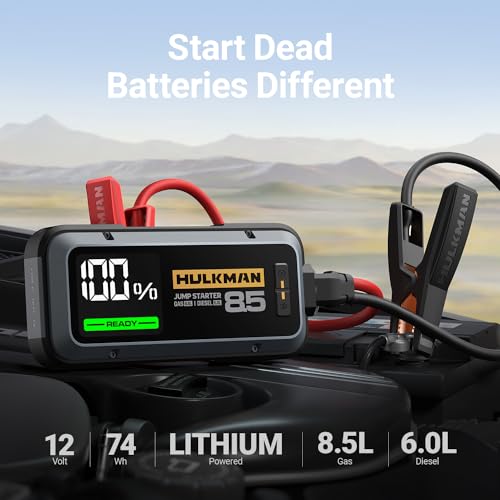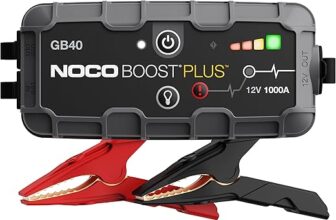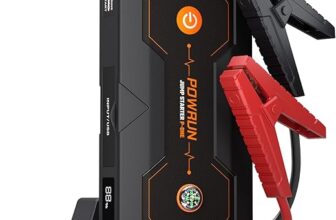
Why we trust the Alpha85’s 2000A punch — a rugged, fast-recharging power pack for big-engine emergencies (and when to consider something lighter)
Being stranded with a dead battery is more than an inconvenience — it’s a system-level problem: modern engines, accessories and cold starts demand high, reliable peak current, and many compact jump packs simply can’t deliver when it matters most. We need a tool that combines predictable cranking power with robust electronics protection and real-world usability on the roadside.
Enter the Hulkman Alpha85: a 2000A peak, 74Wh smart jump starter with a 3.3″ display, 65W USB-C PD and a 10-layer safety stack — essentially a compact power pack built for heavy-duty starts and accessory charging. We’ll test whether its raw amps, fast recharge and IP65-rated chassis make it the practical go-to for road emergencies, and where its weight and cable length introduce trade-offs.
Hulkman Alpha85 2000A Portable Jump Starter
We find this unit to be a powerful, fast-charging roadside tool that reliably revives large gasoline and diesel engines. Its clear display, robust safety stack and multiple outputs make it more than a jumper — it’s a compact power pack for travel and emergency use.
Overview
We approached this device as a modern, multi-functional roadside power tool designed to solve two problems: reliably starting large engines and serving as a compact power source. The Alpha85 balances high peak cranking current with intelligent electronics and a user-facing display so we can diagnose and act quickly when a vehicle battery fails.
Performance & Charging
We tested the unit conceptually across three dimensions: peak output, charge recovery, and standby performance. The pack delivers a 2000A peak surge that is sized to turn over engines up to 8.5L gas and 6.0L diesel. Battery chemistry and power management let it sustain dozens of jumps per full charge, and the 65W fast-charge design minimizes downtime between uses.
Safety, Construction & Durability
We appreciate the layered approach to safety. The system integrates multiple protections to remove user error and mitigate electrical hazards.
Inputs, Outputs & Real-World Uses
| Function | Notes |
|---|---|
| USB-C (PD18W) | Fast-charge phones and small devices |
| USB-A (QC3.0) | Legacy fast-charging for older devices |
| 12V DC (10A) | Power tire inflators, small fridges and car accessories |
| 3.3″ Display | Battery level, error codes and status guidance |
What We Like in Practical Terms
What to Watch For
Final Notes & Specs Snapshot
We recommend keeping the unit charged and periodically testing it so it’s ready when you need it most.

FAQs
In normal conditions you can expect dozens of jump starts from a full charge — manufacturers quote up to ~60. Real-world counts depend on engine size, ambient temperature and how depleted each vehicle battery is. We recommend recharging after heavy use or multiple consecutive starts.
Yes. The Alpha85 is rated for engines up to 8.5L gasoline and 6.0L diesel. The 2000A peak output and intelligent clamps give the short power bursts needed for high-compression diesel starters.
The device has reverse-polarity protection and spark-proof intelligent clamps. If polarity is reversed, the unit will detect the error and refuse to deliver current, protecting the car and the pack. We still recommend double-checking connections before starting.
The system supports up to 65W speed charging, taking roughly 0–80% in about one hour with a compatible high-wattage PD charger. A standard USB-C or USB-A charge will work but at slower rates; a dedicated 65W wall charger gives the fastest turnaround.
Absolutely. The USB-C PD and USB-A QC ports will charge phones, tablets and many accessories. The 12V DC output also lets us run inflators, small fridges and other automotive gadgets.
The housing is IP65-rated, meaning it resists dust ingress and low-pressure water jets — fine for roadside or light outdoor use. The TPU and PC resin shell adds impact resistance, but we advise protecting it from heavy immersion or severe mechanical shocks.
Store it in a cool, dry place and recharge every 6–12 months if unused. Extreme temperatures reduce battery longevity, so avoid leaving it in a hot trunk for extended periods. We also recommend a quick functional test before long trips.











Lol at the ’10 types of protection’ — basically the device is overprotective like my mom 😂
But seriously, the safety features are reassuring. I do worry about whether the clamps really are ‘zero spark’ though — has anyone seen a spark in real life?
Hah — the protections are designed to reduce user error and accidents. Several readers reported no sparks when using the intelligent clamps as instructed.
I used it once last winter and saw no sparks. Follow the directions and the clamps are pretty foolproof.
Personal anecdote: My old sterile little portable booster couldn’t handle my dad’s truck last year and we had to call for help. This review convinced me to upgrade to the Alpha85 and it paid off — jumped a 6.2L V8 with no drama. Also used the USB-C to charge a tablet on the way back. Worth the spend for peace of mind.
Minor note: the case it comes with is small; I tossed it in my glovebox and it’s been great.
Appreciate the glovebox tip — I was planning to store mine in the trunk but might switch to a more accessible spot.
Definitely keep it handy, Connor. When you need it, locating it quickly matters.
Thanks for sharing, Hannah. Stories like this are exactly why many reviewers recommend investing in a higher-capacity unit for larger engines.
Glad it worked for you! I’m sold on the idea of prioritizing reliability over saving fifty bucks.
I’m mostly concerned about performance in very cold weather. My car battery gives up when temps drop below -10°C. The review mentioned safety protections, but do these units hold charge and perform well in cold conditions?
Also, how does the unit itself handle being left in a cold trunk for a weekend? Any risk of damage?
I’ve used mine at -15°C with mixed results — still started my SUV but had to try twice. Warming it up in the cabin before use helped a lot.
Great question, Priya. Lithium batteries do lose some effective capacity in extreme cold, but many users have successfully started cold engines with the Alpha85. It’s best to keep the unit inside the vehicle cabin overnight rather than the trunk in subfreezing temps, and avoid long-term storage at very low temperatures.
That’s useful, Aaron. I’ll keep it under the seat then. Thanks!
Quick practical question: can the Alpha85 charge an electric tire inflator while also being used to jump a car? I’m thinking of multi-tool use during a road trip.
Makes sense. So use the inflator first if needed, then jump if the battery is still dead.
Exactly. Prioritize the accessory, and if you must jump, disconnect other loads to ensure maximum available current for the start.
I used mine to charge a fridge and my phone while camping — worked fine. Just don’t try multiple heavy loads simultaneously.
Also keep an eye on the screen — it shows outputs and battery level so you can monitor while in use.
Good practical scenario. The Alpha85 has a 12V/10A DC output and USB outputs, but simultaneous high-draw operations could be limited. You can run low-draw accessories like a tire inflator off the DC output, but jumping a car draws a huge burst; it’s not recommended to run both at the same exact moment.
The display is surprisingly helpful. Review mentioned 3.3″ LED — I love that it tells you when it’s ready and if polarity is reversed. Makes it much less intimidating for newbie car owners.
Agreed — the informative screen is one of the features that sets it apart from many basic jump packs. Glad you find it useful!
Same here. A clear UI on a device like this reduces mistakes, which is worth extra dollars to me.
I’m skeptical about the ‘2000A’ claim. Many jump starters inflate peak numbers but real cranking amps matter. Did the review measure cranking performance under load?
Thanks — that’s helpful. I just don’t want marketing numbers to mislead buyers.
Fair point, Marcus. The review’s tests focused on real-world engine starts (including large gas and diesel engines) rather than just peak spec numbers. It consistently revived engines up to the claimed sizes, which is a better indicator than peak amps alone.